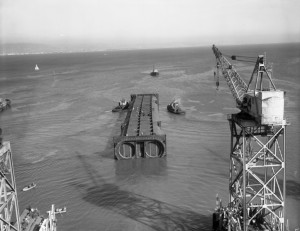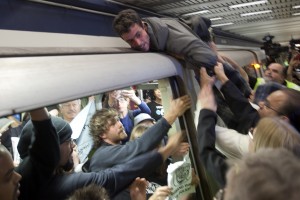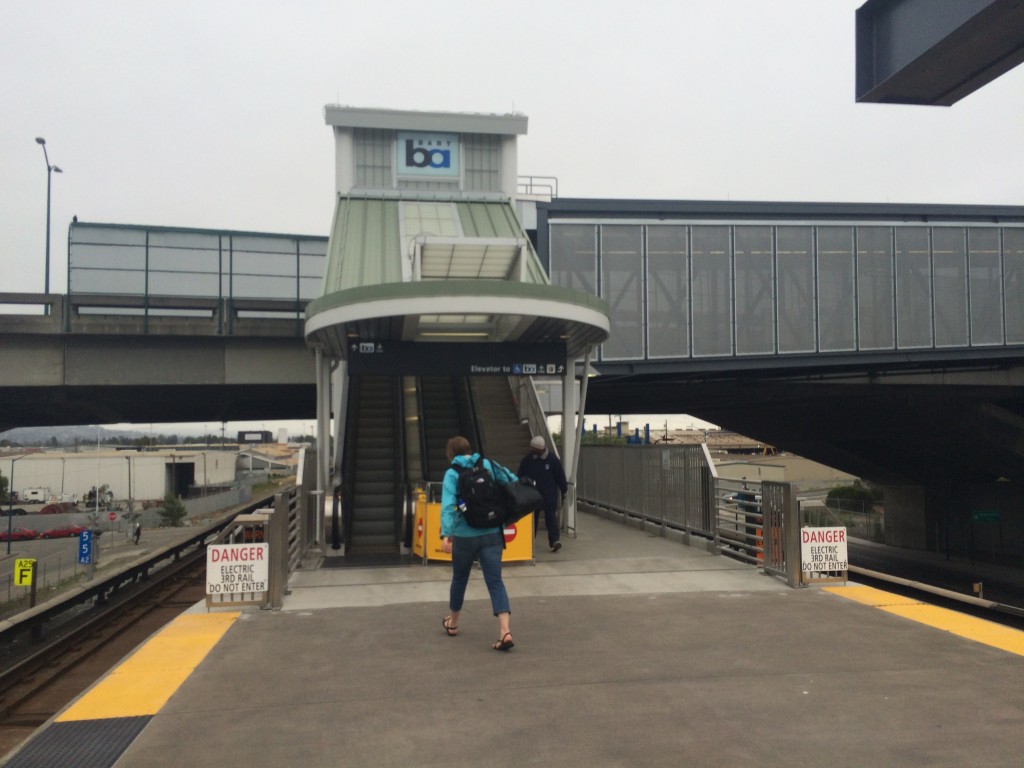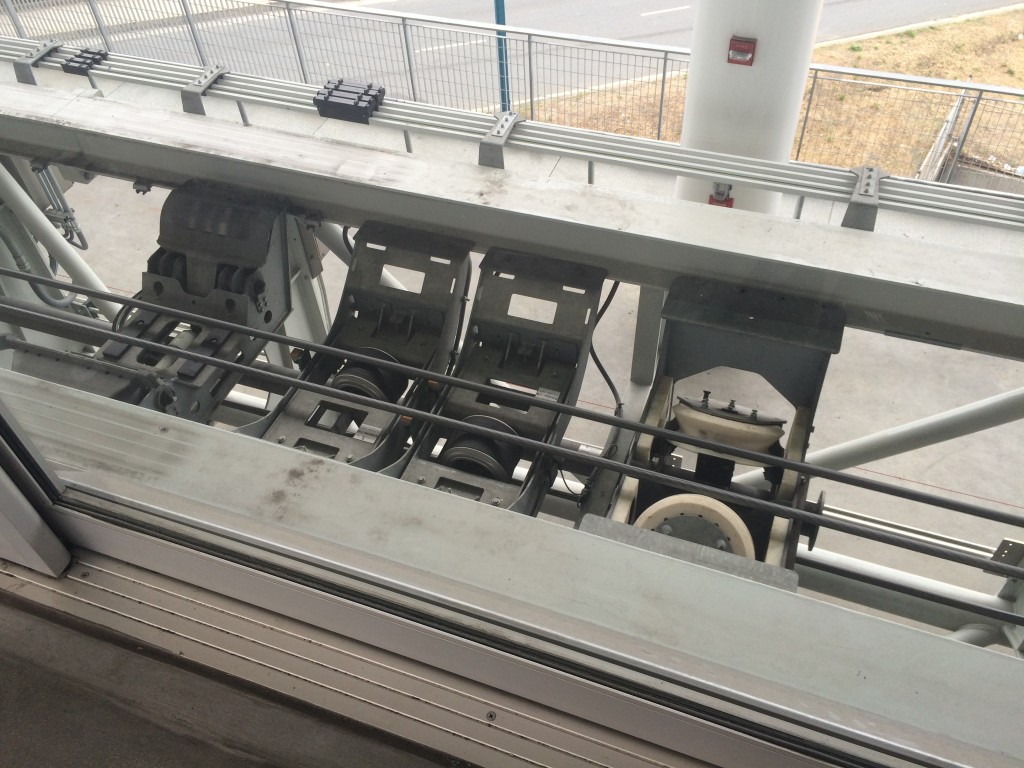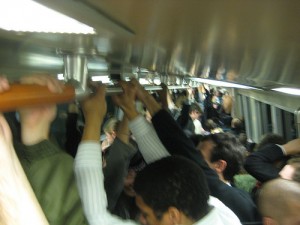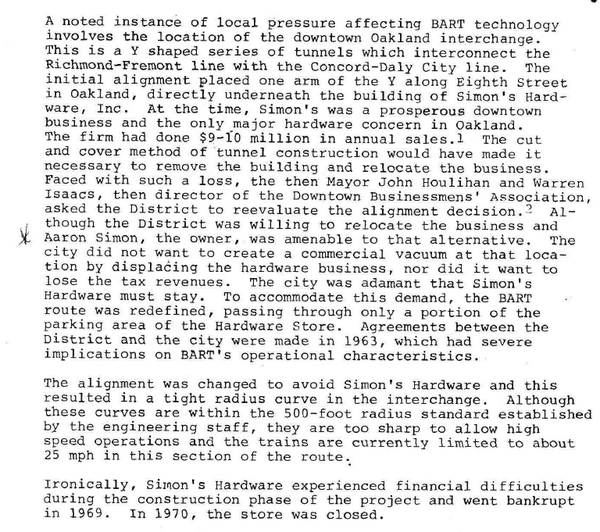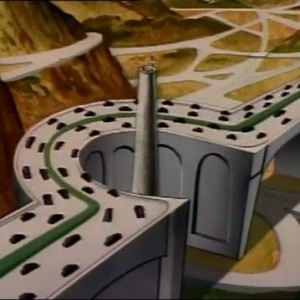BART under the San Francisco Bay is crowded and a major choke point for regional transportation. Monday night I guest hosted a discussion on City Visions on KALW radio on the prospects of building a second rail tube. The audio is now available here.
Some big picture points that emerged:
- The exact route is undefined and would hinge on further study;
- Further study would also be required to determine what kind of rail technology (BART, high speed rail, Caltrain, or a mix?) would be accommodated in the tube; and
- A potential bond issue this fall to expand and invest in BART would also have some funding to do this study.
From my perspective, additional rail capacity under the Bay is needed. But the region shouldn’t fall into the trap of putting all the transportation eggs in that basket. Even if the project moves forward, it will (sadly) take decades to plan and build.
We should be putting our energy now into figuring out how to make better use of existing capacity and determining if there are more cost-effective ways to move more people across the bay. As Rebecca Saltzman discussed on the show, one relatively simple way would be to convert a lane on the Bay Bridge to bus-only.
And the potential bike path from Treasure Island to San Francisco could also be a relatively good bargain for moving people, if it can then connect to the existing bike path on the eastern span. Matier and Ross of the San Francisco Chronicle reported on design options for it just this morning.
Meanwhile, if the second transbay tube does move forward, I hope there is serious consideration of policy reforms that could speed up the construction and lower the price tag. Because even with other intermediate fixes, the regional transportation problem will only get worse as the population grows.
Tonight I’ll be making my radio talk show host debut on KALW radio’s City Visions program in San Francisco. I’ll be guest hosting a discussion on whether the San Francisco Bay Area should start planning now for a second BART/rail tube under the bay to deal with growing transit congestion.
Joining me in-studio will be:
- Ratna Amin – Transportation Policy Director at SPUR, a San Francisco Bay Area planning and urban research association.
- Jeffrey Heller – President of Heller Manus Architects and Co-Chair of the Bay Area Council Transportation Committee.
- Rebecca Saltzman – A Director on the BART Board since 2012 representing District 3, which includes parts of Alameda and Contra Costa counties.
Bay Area residents can tune in at 91.7 FM, while others can stream it on-line. Hope you can listen and call in with questions! I’ll post a link after the show.
While Los Angeles is struggling with flat rail transit ridership of late, the San Francisco Bay Area’s BART system is having a different problem: too many riders, particularly at peak times. And since the whole system funnels through a tunnel between Oakland and San Francisco, the problem has only become more intense in recent years.
On Monday at 7pm I’ll be guest hosting a radio program on KALW 91.7 FM in San Francisco to discuss the prospects of putting in a second rail tube under the bay to address the congestion. Guests will include BART director Rebecca Saltzman, Ratna Amin from SPUR, and architect Jeffrey Heller.
But while the region debates this long-term infrastructure solution, what can be done to address the problem in the meantime? It’s recently gotten worse due to strange power surges that are knocking train cars out of commission, as the San Francisco Chronicle reported today.
BART has announced a new incentive program to encourage riders to use the trains at off-peak hours. But for some strange reason, the agency has ruled out changing the fare structure to encourage this switch. As with Washington DC’s Metro, BART could charge more at peak times and less at off-peak times, in order to distribute the riders more evenly throughout the day and therefore give riders a more reliable, pleasant trip.
The downside? It could negatively impact low-income riders who have no choice but to commute during peak times. Or it could hurt overall ridership if too many people have to travel during peak times and would therefore seek other ways to commute.
But the upside could be a better functioning system that attracts more riders and keeps existing ones from bailing on crowded, unreliable trains.
All in all, I think it’s worth BART at least experimenting with variable fares. It’s a promising way to make use of a fixed resource and deal with the growing demand, particularly while we devise plans for long-term investments in the system.
It’s been one year since Oakland’s AirBART “people-mover” connector to the airport opened, and so far some good news on the cost front. The San Francisco Chronicle reports that ridership is 37 percent higher than projected, and the $6 one-way fare is covering all operating costs.
But Matier & Ross in the Chronicle also noted today that the revenue won’t repay the capital costs to build the system. Those costs totaled $384 million from federal and state sources, as well as local transportation funds. BART also spent $111 million from sales tax revenue bonds, financed by taxpayers in San Francisco, Alameda and Contra Costa counties.
Still, having farebox revenue cover the full operating cost is pretty much unheard-of with rail projects. And that was the goal of transportation equity advocates who encouraged BART to set the fare so high. They didn’t want AirBART sucking in operating funds from other projects. So BART should be applauded for having a fare that covers these costs and also isn’t scaring away riders.
There’s a lot to like about AirBART, despite my previous criticism of the high fare and decision to make it an elevated rail line rather than a bus-only lane. Having now ridden it, I still wouldn’t take my whole family on it, given the cost, but I am happy to ride it as a solo business traveler.
As you can see in the photo below, the system seamlessly integrates with the BART platform, eliminating the unpleasant wait at street level for the old bus.
But the slow cable car feature is unfortunate. You can see the cable in the photo below. It limits the ride to 23 miles per hour and features a strange midway interruption as the train cars switch to a new cable for the final ride into the airport.
But on the plus side, it’s a smooth ride and it’s nice to be elevated above street level. The views are definitely pleasant.
The bottom line: it’s a nice ride but at a steep price. As long as ridership is covering operating costs, complaints should be minimized. But it will remain an open question: had that money been used to build a speedy bus-only lane service, would ridership be even higher, providing more value to more people? And could the leftover capital funds have been used to improve rail service elsewhere in a more cost-effective manner?
We’ll never know, but in the meantime, the airport and BART have a very visible symbol of luxury transit. And at least for now, it’s paying for itself.
Despite surging ridership on Bay Area transit systems and calls for a new BART tube to alleviate the congestion, the sad truth is that transit use, as a percentage of total travelers, is down in the region. As Matier & Ross in the San Francisco Chronicle report:
The problem is not so much ridership on transit, as any local straphanger can tell you (if their voices aren’t muffled by the bodies wedged around them). The real issue is that the region has continued to invest billions in infrastructure and development on the periphery. All those sprawl jobs in outlying Pleasanton, Concord, and Silicon Valley mean more and more people have to drive to access them, skewing the overall percentage away from transit. And without more housing in the urban core, more people have to live farther out for an affordable home, further driving up driving, so to speak.Despite tens of billions of dollars in government subsidies and countless incentives, the percentage of Bay Area commuters taking mass transit hasn’t gone up a bit in more than two decades — in fact, it’s declined.
A new study by the Metropolitan Transportation Commission found that while ridership has hit record numbers on BART and Caltrain as the Bay Area’s population has grown, per capita usage of transit has dropped 14 percent since 1991.
In other words, despite all the BART extensions and the new light-rail and bus lines, the slice of the morning commuters jumping into their cars to go work has pretty much stayed the same since before Bill Clinton was president.
Of course, it doesn’t help that BART fares have gone up significantly in recent years.
The overall solution is pretty simply but politically almost impossible: we need to build more jobs and housing in the urban core, around transit stations where the demand is, instead of out in the periphery.
Unfortunately Matier & Ross don’t mention that option.
Eric Fischer provided me with the original account of the Oakland BART tunnel detour, from a fascinating 1975 consultant report on the history of BART:
As with so many historical events, the truth is more complicated than the modern-day retellings indicate. But in this case, the outcome is no less depressing.
Examples of Not-In-My-Backyard (NIMBY) opponents influencing rail systems abound, but this one caught my eye from Nathanael Johnson at Grist:
Here’s an example told to me by Metropolitan Transportation Commission PR man Randy Rentschler: If you have a chance to ride BART in Oakland between the Lake Merritt and 12th Street stations, you’ll notice the train slows to a crawl to make two turns, first one way and then the other. The train makes these turns to avoid the vestigial outlines of a hardware store whose owner didn’t want the subway running under him. The store closed before BART opened — but all the riders since have lost a little bit of their lives to that dispute.
It reminds me of a story I told in Railtown from Ed McSpedon, who oversaw the construction of the Long Beach Blue Line. Auto dealers in downtown Long Beach objected to the line going past their dealerships, arguing that people riding rail don’t buy cars. So they forced a terminus loop through the downtown to reroute and slow the train down. Of course, by the time the line opened, all the dealerships had moved away. So yet again:
“…all the riders since have lost a little bit of their lives to that dispute.”

